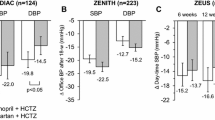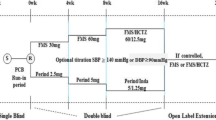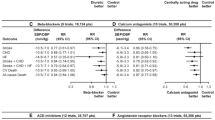Abstract
Background: Angiotensin-converting enzyme inhibitors have been proposed as first-choice drugs for antihypertensive therapy in elderly subjects because of their demonstrated efficacy and safety. However, no information is currently available on the use of zofenopril in elderly hypertensive patients.
Objective: To assess the efficacy and safety of zofenopril (30 or 60mg once daily) compared with lisinopril (10 or 20mg once daily).
Patients and methods: Patients aged ≥65 years with mild to moderate essential hypertension (sitting diastolic blood pressure [DBP] ≥90mm Hg and ≤110mm Hg) were included in the study. They were randomised to receive either zofenopril 30mg or lisinopril 10mg. Blood pressure and heart rate were measured at baseline and after 4 and 12 weeks of treatment. Patients underwent electrocardiography and evaluation of laboratory parameters at baseline and after 12 weeks. Ambulatory blood pressure monitoring (ABPM) was also performed at baseline and after 12 weeks. After 4 weeks drug doses were doubled in patients whose sitting DBP was ≥90mm Hg. The primary endpoint was to achieve sitting DBP values <90mm Hg or a reduction of sitting DBP >10mm Hg after 12 weeks of treatment.
Results: 181 patients were randomised to treatment and 164 patients completed the study. Thirty-three patients were included in the analysis of 24-hour blood pressure monitoring. The percentage of patients with normalised sitting DBP (<90mm Hg) and the rate of treatment responders (reduction of sitting DBP ≥10mm Hg) were not significantly different between the two treatment groups (normalised: zofenopril 81.3% vs lisinopril 76.7%; responders: zofenopril 74.7% vs lisinopril 77.8%). At the end of the treatment sitting DBP was not significantly different between the two treatment groups (zofenopril 82.2 ± 6.6mm Hg vs lisinopril 82.0 ± 7.8mm Hg). Eight percent of patients experienced adverse events in the zofenopril group and 9% in the lisinopril group. A small percentage of adverse events (4%) was related to treatment and reported in the zofenopril group.
Conclusions: In elderly hypertensive patients, treatment with zofenopril was effective and well tolerated. Efficacy and safety were comparable with those of lisinopril.



Similar content being viewed by others
References
SHEP Cooperative Research Group. Prevention of stroke by antihypertensive drug treatment in older persons with isolated systolic hypertension: final results of the Systolic Hypertension in the Elderly Program (SHEP). JAMA 1991; 265(24): 3255–64
MRC Working Party. Medical Research Council trial of treatment of hypertension in older adults: principal results. BMJ 1992; 304: 405–12
Dahlöf B, Lindholm LH, Hansson L, et al. Morbidity and mortality in the Swedish Trial in Old Patients with Hypertension (STOP-Hypertension). Lancet 1991; 338(8778): 1281–5
Staessen LA, Fagard R, Thijs L, et al. Randomised double-blind comparison of placebo and active treatment for older patients with isolated systolic hypertension. The Systolic Hypertension in Europe (Syst-Eur) Trial. Lancet 1997; 350(9080): 757–64
Leonetti G, Zanchetti A. Results of antihypertensive treatment trials in the elderly. Am J Geriatr Cardiol 2002; 11(1): 41–7
World Health Organization-International Society of Hypertension (WHO-ISH) Guidelines for the Management of Hypertension. Guidelines Subcommittee. J Hypertens 1999; 17(2): 151–83
Chobanian AV, Bakris GL, Black HR, et al. The seventh report of the Joint National Committee on Prevention, Detection, Evaluation and Treatment of High Blood Pressure: the JNC 7 report. JAMA 2003; 289(19): 2560–72
Schnaper HW. Angiotensin converting enzyme inhibitors for systemic hypertension in young and elderly patients. Am J Cardiol 1992; 69(10): 54C–8C
Leonetti G, Cuspidi C. Choosing the right ACE inhibitor: a guide to selection. Drugs 1995; 49(4): 516–35
Israili ZH, Hall WD. ACE inhibitors. Differential use in elderly patients with hypertension. Drugs Aging 1995; 7(5): 355–71
Borghi C, Ambrosioni E. Survival of myocardial infarction long-term evaluation-2 working party: double-blind comparison between zofenopril and lisinopril in patients with acute myocardial infarction: results of the Survival of Myocardial Infarction Long-term Evaluation-2 (SMILE-2) study. Am Heart J 2003; 145(1): 80–7
Langtry HD, Markham A. Lisinopril: a review of its pharmacology and clinical efficacy in elderly patients. Drugs Aging 1997; 10(2): 131–66
Laher MS, Natin D, Rao SK, et al. Lisinopril in elderly patients with hypertension. J Cardiovasc Pharmacol 1987; 9 Suppl. 3: S69–71
Pool Pool JL, Nelson EB, Taylor AA. Clinical experience and rationale for angiotensin-converting enzyme inhibition with lisinopril as the initial treatment for hypertension in older patients. Am J Med 1988; 85(3B): 19–24
Chan P, Lin CN, Tomlinson B, et al. Additive effects of diltiazem and lisinopril in the treatment of elderly patients with mild-to-moderate hypertension. Am J Hypertens 1997; 10 (7 Pt 1): 743–9
Lacourciere Y, Gagne C. Influence of zofenopril and low doses of hydrochlorothiazide on plasma lipoproteins in patients with mild to moderate essential hypertension. Am J Hypertens 1989; 2 (11 Pt 1): 861–4
Elijovich F, Laffer CL, Schiffrin EL. The effects of atenolol and zofenopril on plasma atrial natriuretic peptide are due to their interactions with target organ damage of essential hypertensive patients. J Hum Hypertens 1997; 11(5): 313–9
Borghi C, Bacchelli S, Degli Esposti D, et al. A review of the angiotensin-converting enzyme inhibitor, zofenopril, in the treatment of cardiovascular diseases. Expert Opin Pharmacother 2004; 5(9): 1965–77
Mancia G, Parati G. The role of ambulatory blood pressure monitoring in elderly hypertensive patients. Blood Press Suppl 2000; 2: 12–6
Kario K, Pickering TG, Umeda Y, et al. Morning surge in blood pressure as a predictor of silent and clinical cerebrovascular disease in elderly hypertensives: a prospective study. Circulation 2003; 107(10): 1401–6
Kantola I, Terent A, Kataja M, et al. ACE inhibitor therapy with spirapril increases nocturnal hypotensive episodes in elderly hypertensive patients. J Hum Hypertens 2001; 15(12): 873–8
Lacourciere Y, Provencher P. Comparative effects of zofenopril and hydrochlorothiazide on office and ambulatory blood pressures in mild to moderate essential hypertension. Br J Clin Pharmacol 1989; 27(3): 371–6
Whelton A, Dunne Jr B, Glazer N, et al. Twenty-four hour blood pressure effect of once-daily lisinopril, enalapril, and placebo in patients with mild to moderate hypertension. J Hum Hypertens 1992; 6(4): 325–31
Tomei R, Rossi L, Carbonieri E, et al. Antihypertensive effect of lisinopril assessed by 24-hour ambulatory monitoring: a double-blind, placebo-controlled, cross-over study. J Cardiovasc Pharmacol 1992; 19(6): 911–4
Taddei S, Omboni S, Ghiadoni L, et al. Combination of lisinopril and nifedipine GITS increases blood pressure control compared with single drugs in essential hypertensive patients. J Cardiovasc Pharmacol 2003; 41(4): 579–85
Gourlay S, McNeil J, Forbes A, et al. Differences in the acute and chronic antihypertensive effects of lisinopril and enalapril assessed by ambulatory blood pressure monitoring. Clin Exp Hypertens 1993; 15(1): 71–89
Conway J, Coats A. Value of ambulatory blood pressure monitoring in clinical pharmacology. J Hypertens Suppl 1989; 7(3): S29–32
European Society of Hypertension-European Society of Cardiology Guidelines Committee: 2003 European Society of Hypertension-European Society of Cardiology guidelines for the management of arterial hypertension. J Hypertens 2003; 21(6): 1011–53
Burt VL, Whelton P, Roccella EJ, et al. Prevalence of hypertension in the US adult population: results from the Third National Health and Nutrition Examination Survey, 1988-1991. Hypertension 1995; 25(3): 305–13
Fagard RH. Epidemiology of hypertension in the elderly. Am J Geriatr Cardiol 2002; 11(1): 23–8
Franklin SS, Jacobs MJ, Wong ND, et al. Predominance of isolated systolic hypertension among middle-aged and elderly US hypertensives: analysis based on National Health and Nutrition Examination Survey (NHANES) III. Hypertension 2001; 37(3): 869–74
Kannel WB. Fifty years of Framingham Study contributions to understanding hypertension. J Hum Hypertens 2000; 14(2): 83–90
Acknowledgements
This study was supported by a grant from Menarini Industrie Farmaceutiche Riunite. E. Malacco was a paid consultant for Menarini Industrie Farmaceutiche Riunite at the time of the study.
Author information
Authors and Affiliations
Corresponding author
Rights and permissions
About this article
Cite this article
Malacco, E., Piazza, S. & Omboni, S. Zofenopril versus Lisinopril in the Treatment of Essential Hypertension in Elderly Patients. Clin. Drug Investig. 25, 175–182 (2005). https://doi.org/10.2165/00044011-200525030-00003
Published:
Issue Date:
DOI: https://doi.org/10.2165/00044011-200525030-00003




